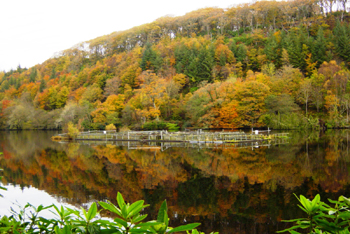Freshwater Finfish Aquaculture
Freshwater finfish aquaculture is an important component of the aquaculture sector, both as a supplier of fish to marine aquaculture and as a producer in its own right. Although dominated by Atlantic salmon production, freshwater aquaculture in Scotland also includes farm production of brown trout and rainbow trout for table and fishery purposes.

The majority of freshwater aquaculture production in Scotland consists of farmed Atlantic salmon. Although salmon farming is normally thought of as belonging in the marine environment, salmon naturally spend part of their lives in both freshwater and seawater. Salmon are hatched and reared through the early stages of life in land-based hatcheries. When they have reached a certain size some of the young salmon are transferred to cage sites in freshwater lochs and some will remain at land-based sites to be on-grown in tanks.
The cages are structures consisting of a floating circular or square pen on the surface of the loch supporting a large net bag hanging in the water. The fish are held in the net bags which allow water to flow past the fish bringing fresh oxygen and carrying away waste products such as carbon dioxide and ammonia. The young salmon remain at the freshwater site until they are approximately one year old, when they become smolts and are able to survive in seawater. At this point the fish are transferred to marine farms, mimicking the natural migrations of wild salmon.
Rainbow trout are reared in freshwater cages, ponds, raceways and tanks. Some will be harvested directly from the freshwater site, but a proportion are transferred to marine farms for on growing to a larger size.
The majority of freshwater finfish aquaculture is undertaken in order to produce fish, principally Atlantic salmon and rainbow trout, for human consumption. However, rainbow and brown trout are also produced in order to stock water bodies for angling. As rainbow trout do not breed in Scotland all rainbow trout fisheries rely on production of rainbow trout from freshwater aquaculture. Atlantic salmon are also produced to stock waterbodies for angling and conservation.